Western Miño Route
This itinerary begins in the town of Os Peares, at the confluence of the Miño and Sil rivers. You will travel along the banks of the Miño River until reaching Chantada, where you can take a stroll through the town and eat at one of its various restaurants. In the afternoon, you can visit the three Romanesque churches in Taboada, and then finish the day at the Castle of A Peroxa, enjoying its natural surroundings and views over the Ourense Valley.
Your day begins in Os Peares, a small town notable for its position at the intersection of four municipalities and two provinces. This is also the location where the Sil and Miño rivers converge, which are the largest rivers that flow through Ribeira Sacra. While in Os Peares, be sure to take a look at the colourful murals painted on the walls of various buildings. They were created as part of the project "A Touch of Colour in Ribeira Sacra", sponsored by the Ribeira Sacra Tourism Consortium.
Next, take the LU-P-1801 highway in the direction of Chantada. After driving for about 15 minutes, you will reach the junction for the Church of San Xoán da Cova. It is best to park your car here and continue on foot (700 metres). One interesting fact about this marvellous Romanesque church is that it was moved from its original location stone-by-stone when the Os Peares dam was constructed.
After visiting the Church of San Xoán da Cova, continue along the same highway until reaching your next stop: Garabullo Rock and Fondós Waterfall (Penedo do Garabullo and Cascada de Fondós). These natural attractions consist of an impressive granite stone outcropping, with a waterfall formed by the Fondós River cascading alongside of it before flowing into the Miño River.
Just another 6 minutes down the same highway you will reach the Sernande Viewpoint. This is a stop you will not want to miss, where you can observe the grandiose course of the Miño River as it passes this location.
Next, continue along the same road in the same direction, until you see the signs indicating the Church of Santa María de Nogueira de Miño. This is truly a gem, because its interior is almost entirely covered with painted murals from the 16th century. It is sometimes referred to as Galicia’s Sistine Chapel...
Now back on the same highway, continue travelling in the same direction until reaching Chantada. Here you can visit the town’s historic centre and take advantage of this location to have lunch.
After stopping here and taking some time to rest, travel on the N-540 in the direction of Lugo to discover more outstanding examples of Romanesque architecture. The first of these will be the Church of Santa María de Piñeira, which you can find by travelling on N-540 (when you reach kilometre point 45.5, you will see a junction on the right with a sign indicating A Refonteira. When you arrive at A Refonteira, turn right to travel towards Pacios, and then from Pacios continue to Piñeira. After you pass through that town you will see the church."
Your next stop will be the Church of Taboada dos Freires, another authentic jewel (see if you can find the original 12th-century inscription...). After this visit, continue on LU-P-6001 towards the east, and after about 10 minutes you will arrive at the Church of San Xián de Campo. In this same location you will also be able to admire a building with a recently restored sgraffito decorations. [no es en la carretera LU-P-6001.
To complete the day, travel towards A Peroxa on the N-540 (direction of Ourense) to visit the site of A Peroxa Castle. Only the lower walls of this castle remain in place, and many of its stones were used to build the local church.
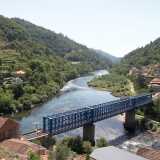
In addition, the town of Os Peares is characterized by being a place of union. The rivers Miño and Sil (also Búbal) meet here, as do four municipalities in two different provinces.
The church of San Xoán da Cova is another of the Romanesque jewels of the Ribeira Sacra, not only because of its construction but also where it stands.
This is a large rock formation with a waterfall on one side, dropping into the river Fondós before it meets the river Miño.
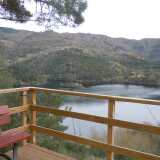
From here you can see the island of Maiorga, a piece of higher land covered in vegetation that was completely surrounded by the waters of the river Miño as the result of the construction of the Os Peares dam.
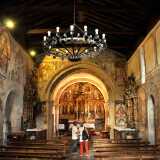
The church stands at the top of the famous Cabo do Mundo meander. Santa Maria de Nogueira combines parts of the second half of the 12th century and late 18th century, a time when significant work was done on the façade, which now features the old Romanesque rose window and bell tower, and baroque shapes.
Between the Miño Canyon and the Dorsal Galega range, with Mount Faro as its summit, the town's beautiful old quarter and numerous examples of Romanesque architecture are particularly striking.
Its size indicates its monastic origin; some sources refer to the existence of another monastery dedicated to El Salvador very close.
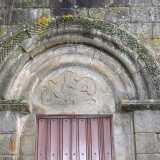
The Taboada dos Freires church was built in the 12th century but underwent significant renovation in 1927. Of the original church, only the main door, a single window at the end of the apse and some corbels in the nave remain.
It was originally built in the 12th century but has been considerably altered since then. The side chapels were built after the original Romanesque structure. The church has granite walls and a ridged tile roof.
The main door has a rounded arch with two half-rounded archivolts. It is also decorated with balls and a chequered pattern, and has columns with decorated capitals. The front of the church is topped by a simple belfry with two openings.
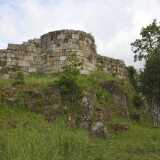
GUIDED TOURS by prior reservation: See timetable section.
The castle is on the site of a castro (a fortified settlement) built by the original inhabitants in the valley of the Rial, a small tributary of the River Miño. In the 8th century, the Temes family ordered a castle to be built here to defend their lands from Muslim raids.
Don't miss!
During the afternoon hours you can also add a boat trip on the Miño River, although you will have to do this as a substitute for another stop on the list.
 What would you improve?
What would you improve? 